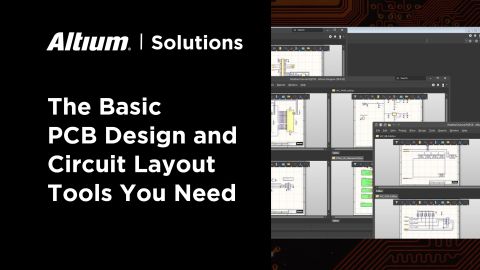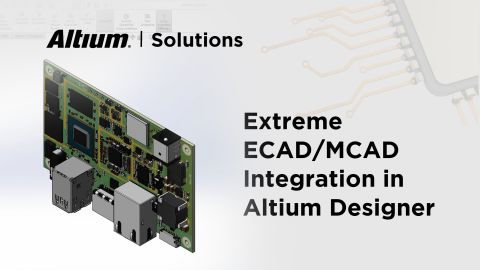Mechanical and Electrical Design Collaboration With MCAD Co-Design

Electronics designers working in small design houses or in large enterprises often encounter a common set of challenges when interfacing with mechanical designers. For many new products, the mechanical form factor requirements will constrain the electrical design collaboration in terms of physical layout, location of interfaces, and component selection.
For many electronic products, flex and rigid-flex board designs require careful modeling of the mechanical behavior of the flex region to ensure form factor constraints are satisfied and the flex regions are reliable. These problems are compounded by faster product release cycles, requiring electrical and mechanical design engineers to work together more than ever.
Success in these areas requires close collaboration between MCAD and ECAD domains to ensure mechanical constraints are not violated, and the finalized design can be produced at scale. Because today’s design and data management systems still lack basic integration features, ECAD-MCAD collaboration still relies on file exchange between each side.
Altium has stepped up to help design teams overcome these ECAD-MCAD collaboration and productivity challenges with Altium MCAD co-design. This simple ECAD to MCAD utility connects Altium Designer projects to popular 3D electrical MCAD applications. By unifying the traditional ECAD/MCAD workflow, multifunctional design teams can participate in collaborative engineering while the ECAD-MCAD integration software eliminates many of the manual file exchange processes normally required as part of enclosure design, constraint definition, and interference back-checking.
Innovative companies like Quantel Laser use the MCAD co-design to collaborate on all aspects of product development. Mixed design teams can have visibility into ECAD and MCAD data, which helps streamline product development and eliminates many inefficiencies in ECAD/MCAD/EDMD collaboration.
Empowering More Efficient Workflows: ECAD-MCAD Collaboration
The MCAD co-design panel and its corresponding add-on panel in MCAD collaboration software allow electrical and mechanical designers to interact seamlessly, enabling an efficient collaborative workflow. Behind the scenes, this workflow is facilitated by robust server-side support, allowing design changes to be transferred, reviewed, and accepted or rejected without the need for manual file transfers in lossy file formats. MCAD co-design provides best-in-class model support by preserving references to board features, ensuring mechanical housing design updates in one application are accurately reflected in the corresponding application.
After the initial component placement is completed by the PCB layout engineer, it becomes the mechanical engineer’s job to check that everything fits the enclosure and communicate the required changes. In many cases, mechanical designers need to perform detailed mechanical checks, finite element analysis (FEA), and placement modifications to ensure mechanical constraints are satisfied. MCAD co-design enables these tasks and many more for PCB assemblies with synchronization and modeling features.
Design Data Synchronization
MCAD co-design implements a simple Push-Pull process, where updates are exchanged between each side with a button in the co-design panel. Updates on one side can be transferred to a colleague in seconds, and this triggers a notification in the collaborator’s co-design panel. Each side can keep track of changes by adding comments to each Push operation. This instant exchange of critical ECAD and MCAD data is accomplished without the need for manual IDF/IDX/STEP/DXF file imports and exports. Engineers in both domains can focus on design collaboration instead of creating and transferring files.

Once the design is imported into an MCAD application, any changes made in the MCAD tool are synchronized back to the ECAD side with the Push-Pull functionality. Once the design is pulled back into Altium Designer, the PCB layout data will immediately update to reflect changes in the board outline, copper, hole placement, or component locations.
Similarly, subsequent changes in Altium Designer can be pushed back into the MCAD side, causing the board model to update once the design is pulled back into the MCAD application. This back-and-forth synchronization is also applied to the enclosure, which can be pushed into Altium Designer.
The push-pull ECAD-MCAD exchange allows for a rapid, iterative collaborative engineering experience across electrical and mechanical domains. Engineers work in their familiar tools, and robust design collaboration software ensures workflows are not interrupted by non-productive tasks like manual file exchanges.

Precise Model Representation
Once a PCB assembly is imported into an MCAD application, the mechanical engineer needs to have precise board geometry and, in many cases, a precise definition of copper and solder masks. That precise model can be used for performing detailed mechanical checks and for finite element analysis (FEA) simulations, such as thermal analysis or vibration analysis.
Synchronized ECAD and MCAD Environments
The MCAD co-design application synchronizes many of the important aspects of an ECAD environment in an MCAD application and vice versa.
- The mechanical designer can work with a model of the PCBA directly in an MCAD application.
- The mechanical designer can select and share elements of an enclosure back to the ECAD application, allowing the EE to see a model of the housing and any relevant constraints.
- Because the MCAD co-design works with native MCAD data directly (and carefully!), any mechanical constraints and dimensions defined among elements on the bare board, PCB components, or enclosure are preserved during each sync. Additionally, since ECAD allows designers to lock components on the PCB, co-design synchronizes ECAD’s “locked” state with MCAD’s “constrained” state.
- A standard method for enforcing mechanical constraints in an electrical design is to define a keep-out region in the MCAD model. Because model references are preserved on each side, keep out can be defined in the MCAD collaboration tool and synchronized back to the ECAD side.
Seamless ECAD-MCAD exchange ensures that collaborating engineers maintain alignment, avoid rework caused by conflicting updates, and accelerate the product development cycle without compromising mechanical or electrical requirements.
ECAD to MCAD Synchronized Constraints
Altium Designer’s native 3D design tools provide constraint and clearance checking in 3D, and the same types of clearance definitions and constraints can be pushed into an MCAD application for use in mechanical object organizers and design tasks. Similarly, these constraints and clearances can be defined in the MCAD application, and they can be pushed back into Altium Designer. This level of synchronization helps expedite interference checking on both sides and allows interferences to be caught early.
ECAD and MCAD Component Linkage
The MCAD co-design automatically synchronizes components placed in the MCAD collaboration tool with corresponding components in the ECAD tool and vice versa. This saves time in design collaboration as the mechanical designer can immediately determine the appropriate location for mechanically constrained components, such as connectors and mounting holes. Placement in the MCAD application helps ensure enclosure constraints are satisfied as the mechanical designer will have full visibility of enclosure constraints, and the component definitions on the ECAD side are synchronized automatically.
Keep-out can be defined as a top or bottom layer in the MCAD tool, and these keep-out assignments will be reflected in the PCB layout and checked for interference against the design rules on the ECAD side. If required, the keep-out shape can be adjusted in Altium Designer and pushed back to the MCAD side.

Bi-Directional Support for Rigid-Flex Boards
Flex and rigid-flex assemblies require additional modeling and evaluation beyond what is applied in rigid PCB assemblies. The MCAD co-design plugin provides support for flex and rigid-flex boards in both directions. Rigid and flex regions, bending lines, and board shapes can be defined in the MCAD application and pushed back into Altium Designer. Once the layout engineer places components and completes initial routing, the design can be evaluated and previewed on the MCAD side alongside an enclosure. Bi-directional support for rigid-flex designs is seamless and follows the same workflow used for rigid PCBs.
Mechanical Support for Multi-Board Assemblies in ECAD and MCAD Tools
Most products contain more than one circuit board, which requires precise placement of mounting elements, board-to-board interconnects, and larger components in the PCB enclosure. MCAD software is often used to plan out these circuit board arrangements so that tooling and mounting can be determined for the PCB enclosure. In addition, the mechanical designer may plan fabrication and assembly steps for the enclosure, followed by exporting manufacturing drawings for parts of the PCB enclosure.
In the traditional approach with ECAD/MCAD integration, multi-board assemblies were handled by importing each individual PCB into an MCAD application and arranging them manually in a 3D model alongside the enclosure. Now that ECAD software like Altium Designer can handle multi-board PCB assemblies in a unified project, MCAD tools can do the same with a 3D model of the PCB arrangement. MCAD users can define the board arrangement and physical interconnects, and these can be pushed back to the ECAD designer to check that logical connections fit within the physical constraints defined on the MCAD side.

Multi-board PCB assembly support in Autodesk Fusion 360
Embedded Cavities Support
One aspect in PCB design that is frequently ignored and often included only for specialty products is embedded cavities. These cavities can either be filled with copper to function as embedded heat sinks or used to mount components within the PCB. Typically, when used for component mounting, embedded cavities accommodate passive SMD parts; however, in theory, integrated circuits could also be positioned in a PCB cavity.
MCAD co-design now supports defining cavities and interference checking in cavities inside MCAD software, such as in PTC Creo, as shown below. Once the cavity is placed and the update is pushed back to the ECAD software, a cavity region will be defined in the PCB, and parts can be placed in the embedded cavity layer as normal. The MCAD user can then check cavity interferences against sidewalls, cavity ceiling (for fully embedded cavities), or planarity to the top board surface.

PCB cavity definition in PTC Creo
ECAD-MCAD Collaboration Means "Over the Wall" Is Over!
The days when PCB assemblies were "thrown over the wall" to mechanical engineers are over, and Altium's design collaboration software is helping design teams overcome the productivity and collaboration challenges created by the traditional ECAD/MCAD workflow. A powerful collaborative engineering tool like the MCAD co-design helps bridge the gap between ECAD and MCAD domains.
Instead of going through repetitive file transfers to collaborate with MCAD users, use the MCAD co-design in Altium. PCB designs can be imported into SolidWorks, Autodesk Inventor, Fusion 360, or PTC Creo, giving you everything needed for product development in a streamlined workflow.
Ready to optimize your ECAD-MCAD collaboration with MCAD co-design? Start collaborating today!











